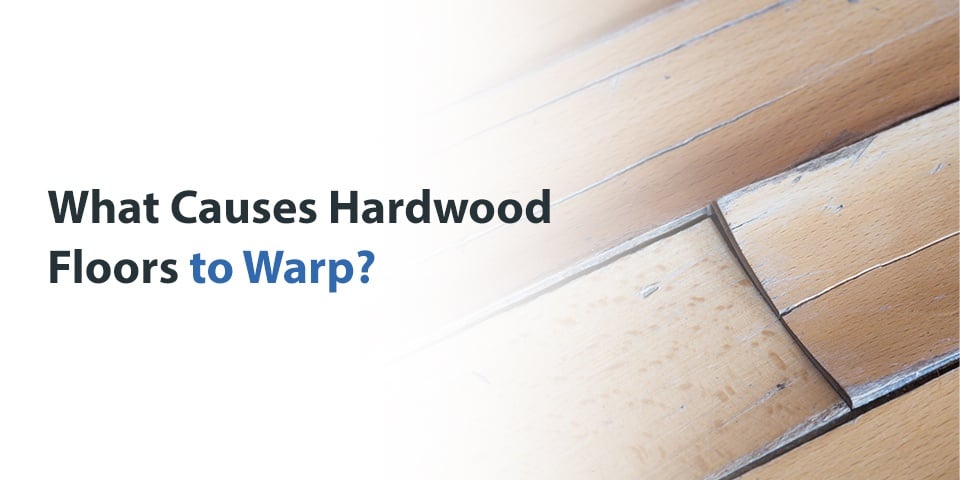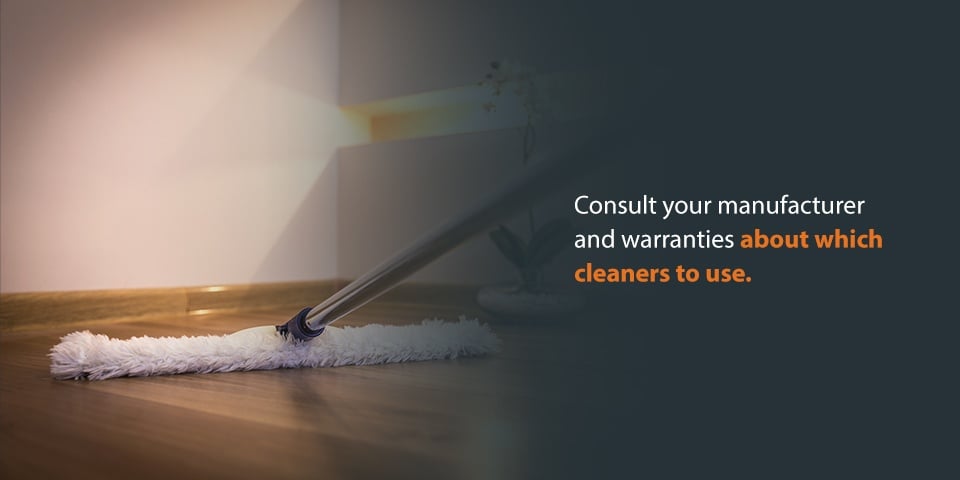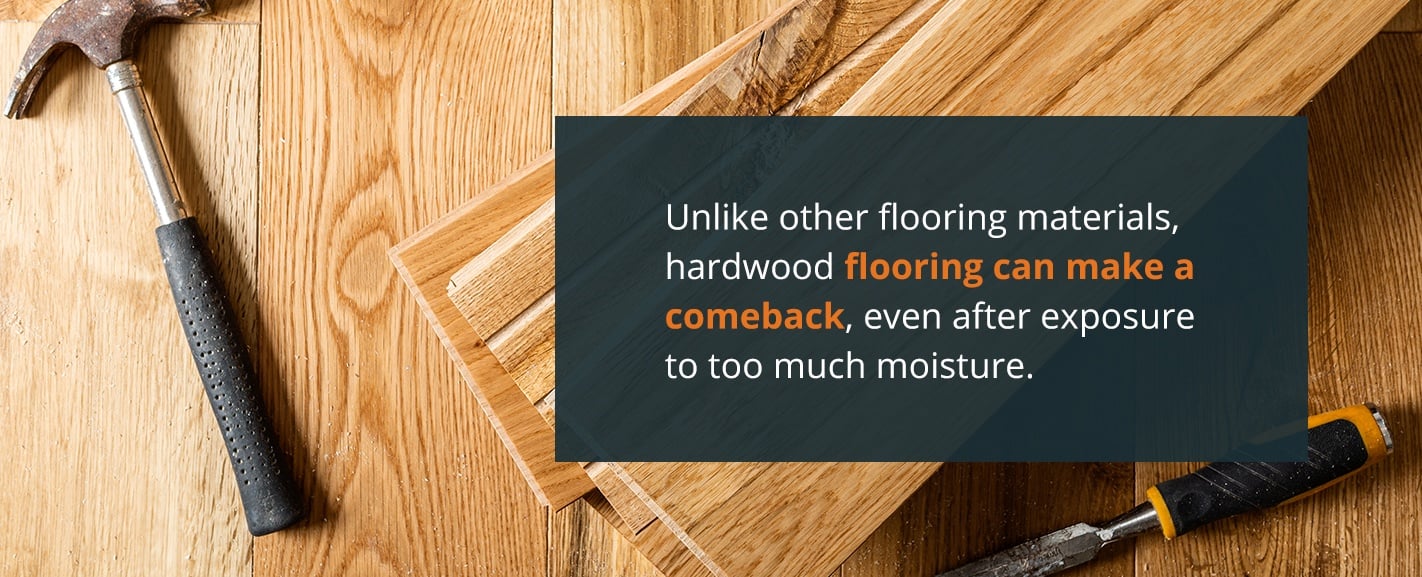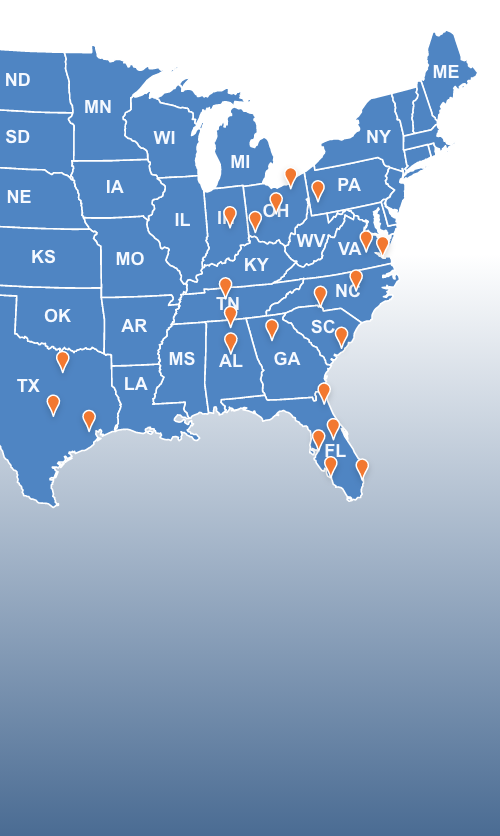

Hardwood flooring is luxurious and can last for up to a century. However, if you don’t maintain it properly, it can warp in the presence of excess moisture and harsh weather conditions. If you have this material throughout your home, explore how to prevent and repair a warped hardwood floor in your living space.
What Are Buckled Wood Floors?
Wood responds to environmental conditions such as water, humidity and poor installation by expanding and contracting. When wood expands and contracts significantly, it might not be able to go back to its regular shape. Wood floorboards buckle when they rise, causing the surface to become uneven and form humps. In some cases, the boards may even lift off of the floor.
What Are the Differences Between Peaking, Buckling and Cupping?
When wood expands and contracts, it can warp in different ways. Peaking, buckling and cupping are three different ways that wood can change shape when it reacts to environmental conditions.
Cupping occurs when floorboards develop a concave shape. When a floorboard cups, it will bend inward to resemble the curve of a spoon, and the sides will raise up higher than the middle section. This type of warping happens when water or humidity saturates the bottom of a floorboard.
Peaking occurs when floorboards form into crested hills. When floorboards expand due to humidity and other conditions, it’s important that they have space between them to accommodate the expansion. When floorboards are installed without the correct amount of space, peaking is common. This type of damage is different from buckling, which forms small peaks and grooves.
How to Identify Damaged Planks
Look out for common signs that your hardwood floors may be damaged and warped. Separations or cracks between floorboards are good indicators. You should also keep an eye out for puffy areas or edges of floorboards that appear lifted. In some cases, you may even notice a damaged plank pull apart from the subfloor.
If you notice any of these signs, it’s important to repair the damage as soon as possible to prevent further warping.
Wood Floor Buckling Causes
Hardwood can become bent or twisted out of shape because of moisture throughout the home or changes in outdoor weather conditions. Consider some of these wood floor buckling causes so you can prevent them from damaging your floors:
- Consistent water on the floorboards: Water is hardwood flooring’s worst enemy. Even though you should clean up spills immediately to prevent damage, one spill isn’t going to hurt your hardwood floors enough for them to buckle. Instead, you should look for sources of consistent moisture, such as drips or leaks. Most damage occurs when floors are consistently exposed to water.
- Changes in temperature: Wood naturally expands in the hot humidity and contracts in the cold. If you live in an area with extreme temperatures, you might notice buckling wood floors in the summer. Try to maintain a healthy relative humidity in your home to prevent damage from the hot, sticky weather.
- Moist wood subfloors: Find the moisture content (MC) of your wood subfloors before installing hardwood flooring. You or the floor installer should test for water throughout your subfloors with a wood moisture meter. If the MC is too high to install your flooring, find the moisture source and fix it before it spreads.
- Concrete subfloors: Like wood subfloors, foundations made from concrete are also prone to moisture accumulation. If the concrete slab hasn’t dried properly, you can almost be sure that your wood flooring will warp on top of it.
- Water leaks: Besides moisture from below your flooring, you should also look at the sources of moisture around your hardwood floors. If you have leaking appliances, condensation or groundwater intrusion, water can get between the subfloor and flooring and cause warped floorboards.
- Poor installation: If you notice water damage near a window or door, the cause might be an improper installation of these openings. During inclement weather, heavy rainfall or snow can allow moisture to seep in through the cracks of your home’s doors and windows. In particular, older homes are more susceptible to water coming in from the outside because of unwanted gaps.
Tips to Avoid Floors Warping


Proper installation is key to preventing warping, but maintaining your hardwood flooring is just as important. When you maintain it properly, hardwood flooring is durable and long-lasting, but warping can shorten its life span. You can prevent hardwood warping by:
- Sealing gaps in your windows and doors: Weather damage from the outside can affect your home’s indoor environment. Check the openings throughout your property for cracks, and seal the gaps with silicone caulk.
- Wiping up spills immediately: Since wood absorbs water quickly, you need to wipe up spills as soon as they happen. Excess water could cause warping and mold growth in your hardwood floorboards. Besides beverages, you should also watch for rainwater from coats and melted snow from boots.
- Checking for leaks: Inspect your appliances and water sources for cracks that could drip onto your hardwood floors. In particular, watch out for drips from your sinks, dishwashers, toilets and washing machines. If you notice water pooling around this household equipment, repair it as soon as possible.
- Regulating the humidity and temperature: Since changes in the atmosphere can damage your flooring, you should do your best to keep it comfortable. Invest in a dehumidifier or a programmable thermostat to monitor the comfort level of your rooms. Most air conditioners can also remove the air’s humidity in the summertime as it cools down your interior living space.
- Only using cleaning products approved by the manufacturer: Even though you may find several cleaning products for hardwood flooring in the store, it’s best to consult your manufacturer and warranty’s about which cleaners to use. Some of these substances could scratch and ruin the finish of your floors.
- Using soft buffing pads: Instead of using a liquid buffer, get rid of scratches with a soft, dry buffing pad. Wipe it in a circular motion to restore the shine of your floors.
- Regularly sweeping your floors: If you don’t maintain your hardwood flooring properly, dirt and grime can get stuck under and inside the planks, lifting them from the subfloor. Instead of letting debris damage your floorboards, dust them at least once a week.
- Applying a polyurethane finish: Even though a polyurethane wood finish won’t make your hardwood flooring waterproof, it does add an extra layer of protection for your floorboards. Consult a flooring specialist to help you apply several coats of finish onto your floors.
View Hardwood Flooring Care Guide
How to Fix Warped Hardwood Floors


If you notice that your hardwood floors have suffered some damage, you could repair them instead of replacing them. Unlike other flooring materials, hardwood flooring can make a comeback, even after exposure to too much moisture. Take the following measures to make your floors look like new:
- Completely dry the floor: Before fixing your hardwood flooring, make sure you dry it thoroughly with a dehumidifier or several large fans. As the floorboards dry, they shrink, so you might need to use a wood filler to repair the gaps. Sometimes after you fix the leaks throughout your house, letting the floors dry is all you need to do to restore them.
- Sand the entire flooring space: If you have widespread moisture damage, you may be able to sand your hardwood floorboards to revive their shape. Before sanding them, ensure you have addressed the moisture problem. If the moisture content of the boards hasn’t been rebalanced, you may experience crowning and gaps between the boards.
- Refinish the floors: After sanding the floorboards to create a smooth surface, you can apply a few polyurethane finish coats. The wood’s stain changes due to sunlight exposure, so it might be challenging to find a color that matches your floor. It’s probably better to refinish the entire floor with a brand-new stain to create a uniform look.
- Replace the floorboards: You could substitute the damaged flooring panels for brand-new ones, but it might be challenging to match the new material with your existing floor. Consult a professional if you want to change out some of the damaged panels.
Schedule an Appointment With 50Floor to Replace Your Warped Floors
If you’ve noticed that your flooring has some buckled pieces and you haven’t updated it in several decades, it might be time to get brand-new hardwood floors. When you schedule an appointment with us, one of our specialists will visit your home and bring samples of our wood species right to your door. We’ll help you choose the best type of hardwood flooring for your needs, whether you have kids, pets or a home with a pool.
Once you’ve made your decision, our team will expertly install your hardwood floors to prevent future damage and keep your floors in good condition for years to come. You can easily coordinate with your existing flooring by checking it against the materials in our inventory. For more information about our products and services, contact us online or call 1-800-50-FLOOR.




